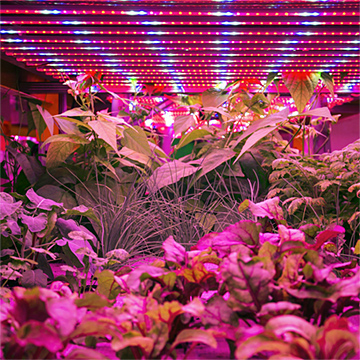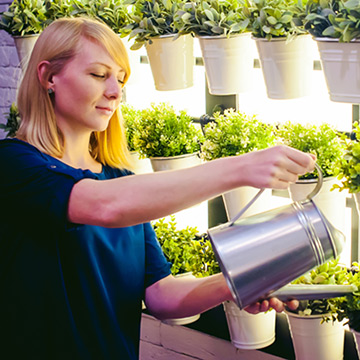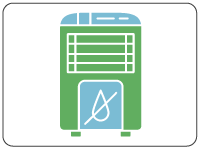Energy Efficient Indoor Growing
Burlington Electric Department customers can reduce energy use while growing plants in their homes and businesses. Our team can help you learn how to minimize increases to your electricity bill caused by the use of growing equipment.
Residential customers can get free advice on efficiency strategies for lighting, ventilation, dehumidification, and air conditioning equipment used for growing. Burlington businesses can receive custom engineering assistance with greenhouse or grow facility projects. Contact Energy Services with your project-specific questions.
All Burlington customers are eligible to receive financial rebates for qualified LED grow light fixtures as part of BED’s regular incentive program supporting a variety of LED products.
Grow Tips
- Try growing outdoors first! Sunlight is the best light for plants, and outdoor grows are a lot more energy efficient and will not impact your electric bill by much.
- Consider grow room location. Growing in a basement in summer minimizes cooling costs, and growing in an attic in winter minimizes heating costs.
 All indoor cultivators use lights to simulate sunshine. Light is the #1 nutrient your plants use for photosynthesis and growth.
All indoor cultivators use lights to simulate sunshine. Light is the #1 nutrient your plants use for photosynthesis and growth.
- Consider what type of light bulb or fixture is right for your plants and their growth cycle. Seedlings need less powerful lights than flowering plants.
- LED light bulbs or light fixtures use less electricity and emit less heat than legacy light bulbs such as fluorescent T5, high pressure sodium, or metal halide.
- Cultivators that use LED light fixtures for growing can achieve lower electricity bills from lighting and cooling.
- Some cultivators use heat mats to keep soil warm while seeds are starting.
- Understand the size of the mat you need. Mats range from 20 to over 100 watts, so size your mat to your grow.
- A 100-watt mat running 24/7 for one month costs approximately $11.50 /per month, whereas a 20-watt mat costs about $2.30 per month.
- Consider controlling heat mats with timers on schedules to keep bills low. Power strips with timers are available for purchase at gardening stores and grow shops.
- Understand the size of the mat you need. Mats range from 20 to over 100 watts, so size your mat to your grow.
- Some cultivators use fans to circulate air.
- Multi-speed oscillating fans can provide energy-efficient grow room ventilation. Standing or wall-mounted fans with these capabilities can provide great ventilation in a space, while allowing growers to tailor the fan speed depending on plant growth cycle.
- In-line fans providing multi-speed, mixed-flow ventilation can be cost-effective and very energy-efficient options for larger facilities.
- Some cultivators use dehumidifiers to remove moisture from the air.
- Consider what relative humidity (RH) setpoint is appropriate for your plants. Depending on growth cycle, plants may need RH setpoints as low as 55%.
- A lower RH setpoint means the dehumidifier may run more often in summer, and can impact your electric bill.
Safety Tips for Indoor Growing
- Before purchasing new equipment, ensure manufacturer specification sheets provide proof of safety testing by certified laboratories like UL, CSA, Intertek, and TUV.
- Consider plugging equipment into surge protectors.
- Keep all power plugs and wires off the ground and away from water.
Dehumidifiers
When purchasing a dehumidifier, look for the ENERGY STAR® label. Certified products remove moisture 15% more efficiently. Choose a dehumidifier on the ENERGY STAR® Most Efficient 2019 list for products offering the greatest energy efficiency to get a larger rebate and greater operating cost savings.
Residential customers can receive cash back on qualified dehumidifiers.
Contact Energy Services to discuss options for energy-efficient commercial dehumidification equipment for your facility.
Residential Customers
 Want to dig deeper, reduce energy use, and save money? Contact Energy Services to get help choosing equipment, locating knowledgeable professionals, and analyzing energy usage to understand your electric bills.
Want to dig deeper, reduce energy use, and save money? Contact Energy Services to get help choosing equipment, locating knowledgeable professionals, and analyzing energy usage to understand your electric bills.
Adding or Replacing Grow Lights
Residential customers can receive cash back on qualified LED light fixtures, and new qualified products are being added to the list often.
Burlington Electric Department has contracted with Efficiency Vermont to administer rebates for indoor LED fixtures for indoor growing. Contact Energy Services with your project-specific questions.
Commercial Customers
Custom Engineering Support
Commercial cultivators of all plants can receive custom rebates for LED lighting, as well as efficient heating, ventilation, and air conditioning (HVAC) and process equipment. Business owners are encouraged to contact Energy Services to understand what custom rebates may be available for lighting, HVAC, dehumidification, and process equipment serving your facility.
Growing Cannabis Indoors
Please visit our Energy Efficient Grower’s Guide to learn more about the potential energy bill impacts of cultivating cannabis and get recommendations for conserving energy with LED lighting and automation.
Additional Resources
- Cultivating Cannabis with LED Lighting: A Primer: What You Need To Know (Resource Innovation Institute)


 Dehumidifer
Dehumidifer